
David Paul Cronenberg is a Canadian film director and screenwriter. He is a principal originator of the body horror genre, with his films exploring visceral bodily transformation, infectious diseases, and the intertwining of the psychological, physical, and technological. Cronenberg is best known for exploring these themes through sci-fi horror films such as Shivers (1975), Scanners (1981), Videodrome (1983) and The Fly (1986), though he has also directed dramas, psychological thrillers and gangster films.

Naked Lunch is a 1991 surrealist science fiction drama film written and directed by David Cronenberg and starring Peter Weller, Judy Davis, Ian Holm, and Roy Scheider. It is an adaptation of William S. Burroughs's 1959 novel of the same name, and an international co-production of Canada, Britain, and Japan.
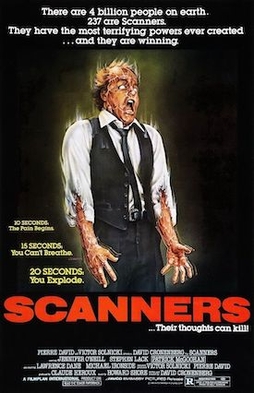
Scanners is a 1981 Canadian science fiction horror film written and directed by David Cronenberg and starring Stephen Lack, Jennifer O'Neill, Michael Ironside, and Patrick McGoohan. In the film, "scanners" are psychics with unusual telepathic and telekinetic powers. ConSec, a purveyor of weaponry and security systems, searches out scanners to use them for its own purposes. The film's plot concerns the attempt by Darryl Revok (Ironside), a renegade scanner, to wage a war against ConSec. Another scanner, Cameron Vale (Lack), is dispatched by ConSec to stop Revok.
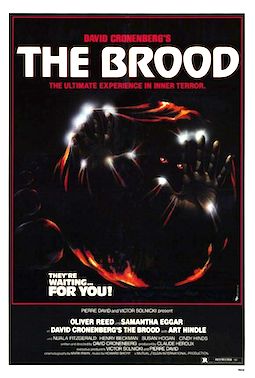
The Brood is a 1979 Canadian psychological body horror film written and directed by David Cronenberg and starring Oliver Reed, Samantha Eggar, and Art Hindle. Its plot follows a man and his mentally ill ex-wife, who has been sequestered by a psychiatrist known for his controversial therapy techniques. A series of brutal unsolved murders serves as the backdrop for the central narrative.
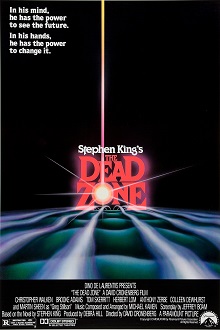
The Dead Zone is a 1983 American science-fiction thriller film directed by David Cronenberg. The screenplay, by Jeffrey Boam, is based on the 1979 novel of the same title by Stephen King. The film stars Christopher Walken, Brooke Adams, Tom Skerritt, Herbert Lom, Martin Sheen, Anthony Zerbe, and Colleen Dewhurst. Walken plays a schoolteacher, Johnny Smith, who awakens from a coma to find he has psychic powers. The film received positive reviews. The novel also inspired a television series of the same name in the early 2000s, starring Anthony Michael Hall, the pilot episode of which borrowed some ideas and changes used in the 1983 film.
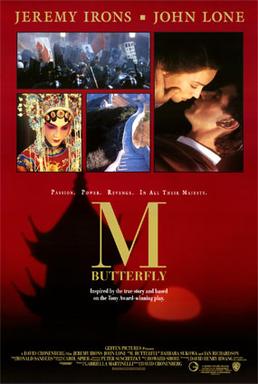
M. Butterfly is a 1993 American romantic drama film directed by David Cronenberg. The screenplay was written by David Henry Hwang based on his play of the same name. The film stars Jeremy Irons and John Lone, with Ian Richardson, Barbara Sukowa, and Annabel Leventon. The story is loosely based on true events which involved French diplomat Bernard Boursicot and Chinese opera singer Shi Pei Pu.

Videodrome is a 1983 Canadian science fiction body horror film written and directed by David Cronenberg and starring James Woods, Sonja Smits, and Debbie Harry. Set in Toronto during the early 1980s, it follows the CEO of a small UHF television station who stumbles upon a broadcast signal of snuff films. Layers of deception and mind-control conspiracy unfold as he attempts to uncover the signal's source, complicated by increasingly intense hallucinations that cause him to lose his grasp on reality.
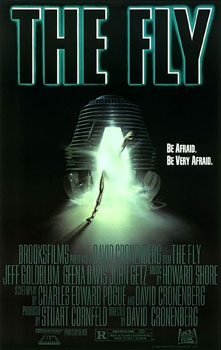
The Fly is a 1986 American science fiction horror film directed and co-written by David Cronenberg. Produced by Brooksfilms and distributed by 20th Century Fox, the film stars Jeff Goldblum, Geena Davis and John Getz. Loosely based on George Langelaan's 1957 short story of the same name and the 1958 film of the same name, The Fly tells of an eccentric scientist who, after one of his experiments goes wrong, slowly turns into a fly-hybrid creature. The score was composed by Howard Shore and the make-up effects were created by Chris Walas, along with makeup artist Stephan Dupuis.

Dead Ringers is a 1988 psychological thriller film starring Jeremy Irons in a dual role as identical twin gynecologists. David Cronenberg directed and co-wrote the screenplay with Norman Snider. Their script was based on the lives of Stewart and Cyril Marcus and on the novel Twins by Bari Wood and Jack Geasland, a "highly fictionalized" version of the Marcuses' story.
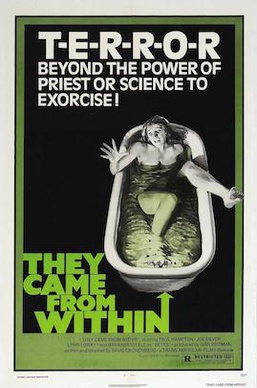
Shivers, also known as The Parasite Murders and They Came from Within, and, for Canadian distribution in French, Frissons, is a 1975 Canadian science fiction body horror film written and directed by David Cronenberg and starring Paul Hampton, Lynn Lowry, and Barbara Steele.

Crash is a 1996 Canadian drama film written, produced and directed by David Cronenberg, based on J. G. Ballard's 1973 novel of the same name. Starring James Spader, Deborah Kara Unger, Elias Koteas, Holly Hunter and Rosanna Arquette, it follows a film producer who, after surviving a car crash, becomes involved with a group of symphorophiliacs who are aroused by car crashes and tries to rekindle his sexual relationship with his wife.

Stereo is a 1969 Canadian science fiction film directed, written, produced, shot and edited by David Cronenberg in his feature film debut. Starring Ronald Mlodzik, who would go on to appear in later Cronenberg films Crimes of the Future, Shivers, and Rabid, the film was Cronenberg's first feature-length effort, following his two short films, Transfer (1966) and From the Drain (1967). The plot follows several young volunteers who participate in a parapsychological experiment.

Crimes of the Future is a 1970 Canadian science fiction film written, shot, edited and directed by David Cronenberg. Like Cronenberg's previous feature, Stereo, Crimes of the Future was shot silent with a commentary added afterwards, spoken by the character Adrian Tripod.

Fast Company is a 1979 Canadian action film directed by David Cronenberg and starring William Smith, John Saxon, Claudia Jennings and Nicholas Campbell. It was written by Phil Savath, Courtney Smith, Alan Treen and Cronenberg. It was primarily filmed at Edmonton International Speedway, in addition to other locations in Edmonton, Alberta, and Western Canada.

Not a Love Story: A Film About Pornography is a Canadian documentary film about the pornography industry, directed by Bonnie Sherr Klein and released in 1981.
Rabies has been the main plot device or a significant theme in many fictional works. Due to the long history of the virus as well as its neurotropic nature, rabies has been a potent symbol of madness, irrationalism, or an unstoppable plague in numerous fictional works, in many genres. Many notable examples are listed below.
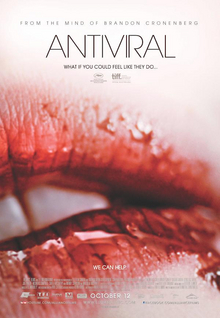
Antiviral is a 2012 science fiction horror film written and directed by Brandon Cronenberg. The film competed in the Un Certain Regard section at the 2012 Cannes Film Festival. Cronenberg re-edited the film after the festival to make it tighter, trimming nearly six minutes out of the film. The revised film was first shown at the 2012 Toronto International Film Festival, and was a co-winner, alongside Jason Buxton's Blackbird, of the festival's Best Canadian First Feature Film award.
Patricia Gage was a Scottish-born actress based in Canada.

Bite is a 2015 Canadian body horror film written and directed by Chad Archibald, and starring Elma Begovic, Annette Wozniak, Denise Yuen, Jordan Gray, Lawrene Denkers, Barry Birnberg, Daniel Klimitz, Tianna Nori, and Caroline Palmer. It was produced by Black Fawn Films, MGM Productions and Scream Factory, and Breakthrough Entertainment. The plot is about a young woman who is bitten by a waterborne insect whilst in Costa Rica and suffers horrifying and transformative consequences.

Rabid is a 2019 Canadian body horror film directed and co-written by Jen and Sylvia Soska and starring Laura Vandervoort, Ben Hollingsworth, and Phil Brooks. It is a remake of the 1977 film of the same name directed by David Cronenberg.

















